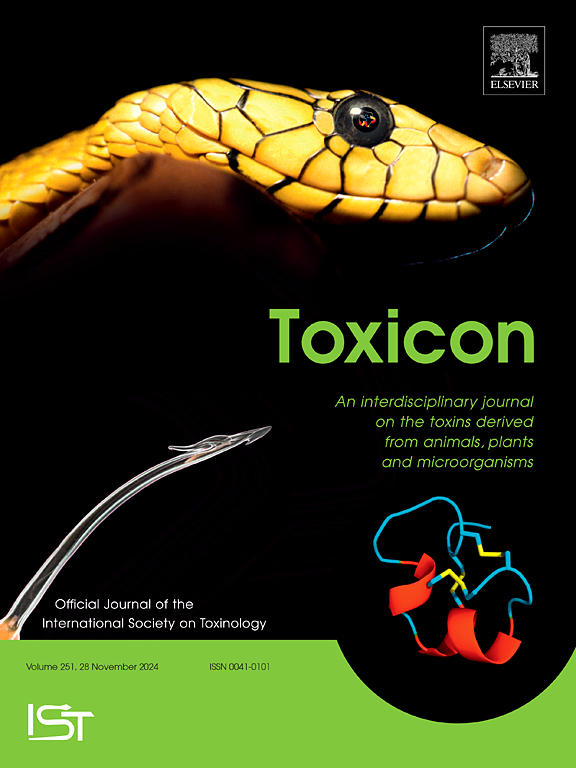河口石鱼鱼鳞毒素的地理变异
IF 2.6
4区 医学
Q2 PHARMACOLOGY & PHARMACY
引用次数: 0
摘要
动物毒素组成的地理差异在有毒类群中得到了充分的记录,在较小程度上,一些有毒类群分泌从其饮食中获得的毒素。然而,人们对重新合成毒素的动物知之甚少,比如石鱼和它们分泌的鱼激素毒素。石鱼广泛分布在整个印度-太平洋地区,然而,位置对其鱼细胞毒素组成的影响目前尚不清楚。本研究旨在确定三种地理上孤立的澳大利亚种群,包括昆士兰州北部的凯恩斯、昆士兰州东南部的卡隆德拉和西澳大利亚的埃克斯茅斯之间,Synanceia horda(河口石鱼)的鱼细胞毒素成分是否存在差异。在这三个地点,恐怖s.h orida的鱼细胞毒素的组成基本保守,大部分成分的大小在14 ~ 25 kDa之间。然而,从Caloundra和Exmouth种群中鉴定出了独特的成分。Caloundra群体含有独特的较小的疏水性成分(8和12 kDa)。相比之下,Exmouth群体具有独特的较大成分(60和150 kDa),但在疏水性方面没有差异。我们推测,由s.h orida产生的鱼细胞毒素的组成可能受到底栖动植物群落的影响,特别是那些可能与动物皮肤相互作用的底栖动植物群落,如污染的动植物以及寄生虫。这些发现进一步增加了越来越多的证据,强调了石鱼产生的鱼细胞毒素的复杂性和组成多样性。本文章由计算机程序翻译,如有差异,请以英文原文为准。

Geographic variation in ichthyocrinotoxin from the Estuarine Stonefish (Synanceia horrida)
Geographic variation in the composition of animal toxins is well documented for venomous taxa, and to a lesser degree, for some poisonous taxa that secrete toxins obtained from their diet. However, very little is known about animals that synthesise their poisons de novo, such as stonefish and their secreted ichthyocrinotoxins. Stonefish are widely distributed throughout the Indo-Pacific, however, the effect of location on the composition of their ichthyocrinotoxin is currently unknown. This study aimed to determine whether the composition of ichthyocrinotoxins from Synanceia horrida (Estuarine Stonefish) varied between three geographically isolated Australian populations including Cairns in far north Queensland, Caloundra in southeast Queensland, and Exmouth in Western Australia. The composition of ichthyocrinotoxins from S. horrida were largely conserved across the three locations, with the size of most of the components falling between 14 and 25 kDa. However, unique components were identified in S. horrida ichthyocrinotoxins from Caloundra and Exmouth populations. Caloundra populations contained unique smaller components (8 and 12 kDa) that were hydrophobic. In contrast, Exmouth populations contained unique larger components (60 and 150 kDa) with no difference in hydrophobicity. We speculate that the composition of ichthyocrinotoxins produced by S. horrida are likely influenced by benthic flora and fauna communities, particularly those that are likely to interact with the animal's skin, such as fouling flora and fauna, as well as parasites. These findings further add to the growing body of evidence underscoring the complexity and compositional diversity of ichthyocrinotoxins produced by stonefish.
求助全文
通过发布文献求助,成功后即可免费获取论文全文。
去求助
来源期刊

Toxicon
医学-毒理学
CiteScore
4.80
自引率
10.70%
发文量
358
审稿时长
68 days
期刊介绍:
Toxicon has an open access mirror Toxicon: X, sharing the same aims and scope, editorial team, submission system and rigorous peer review. An introductory offer Toxicon: X - full waiver of the Open Access fee.
Toxicon''s "aims and scope" are to publish:
-articles containing the results of original research on problems related to toxins derived from animals, plants and microorganisms
-papers on novel findings related to the chemical, pharmacological, toxicological, and immunological properties of natural toxins
-molecular biological studies of toxins and other genes from poisonous and venomous organisms that advance understanding of the role or function of toxins
-clinical observations on poisoning and envenoming where a new therapeutic principle has been proposed or a decidedly superior clinical result has been obtained.
-material on the use of toxins as tools in studying biological processes and material on subjects related to venom and antivenom problems.
-articles on the translational application of toxins, for example as drugs and insecticides
-epidemiological studies on envenoming or poisoning, so long as they highlight a previously unrecognised medical problem or provide insight into the prevention or medical treatment of envenoming or poisoning. Retrospective surveys of hospital records, especially those lacking species identification, will not be considered for publication. Properly designed prospective community-based surveys are strongly encouraged.
-articles describing well-known activities of venoms, such as antibacterial, anticancer, and analgesic activities of arachnid venoms, without any attempt to define the mechanism of action or purify the active component, will not be considered for publication in Toxicon.
-review articles on problems related to toxinology.
To encourage the exchange of ideas, sections of the journal may be devoted to Short Communications, Letters to the Editor and activities of the affiliated societies.
 求助内容:
求助内容: 应助结果提醒方式:
应助结果提醒方式:


